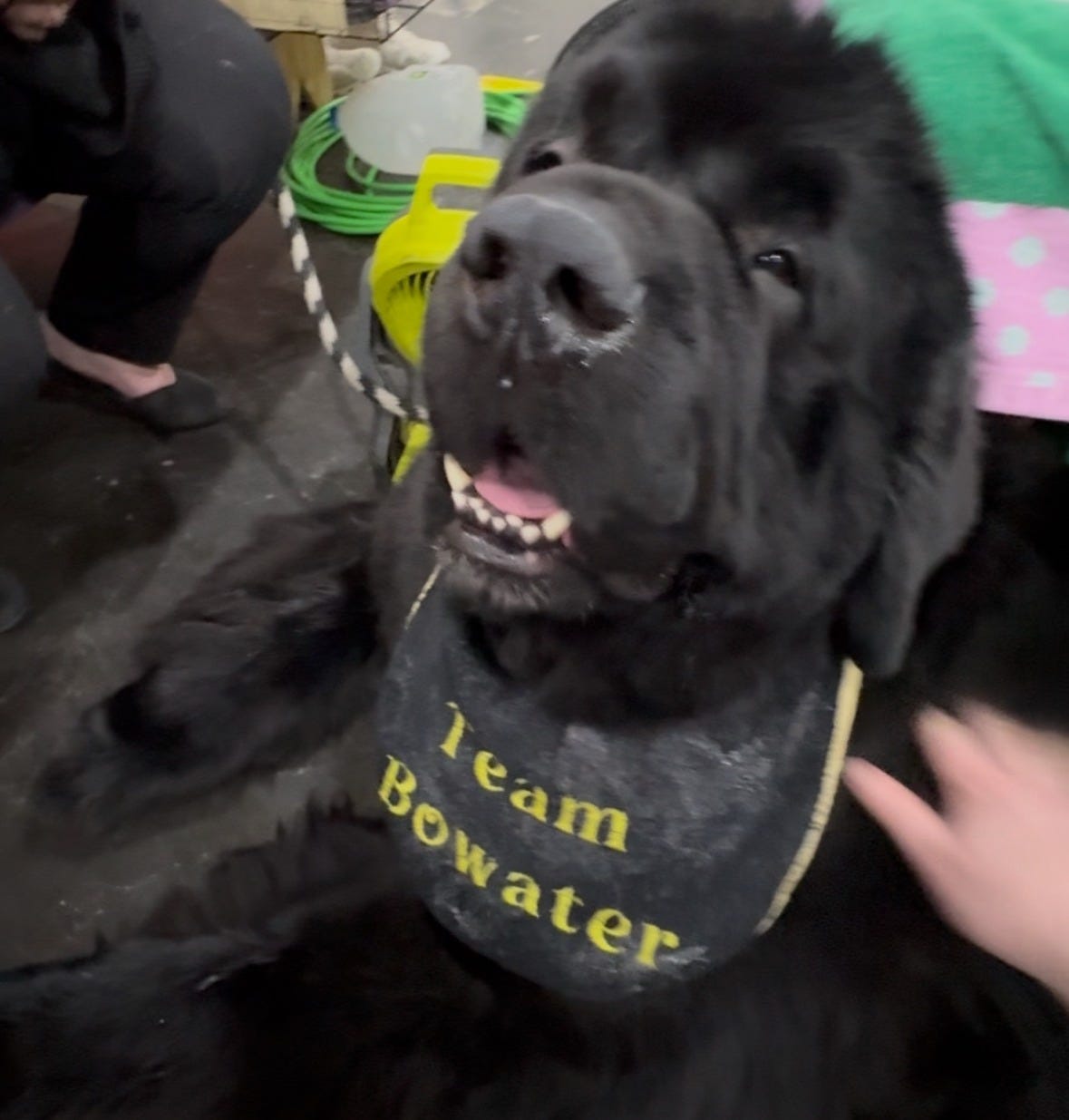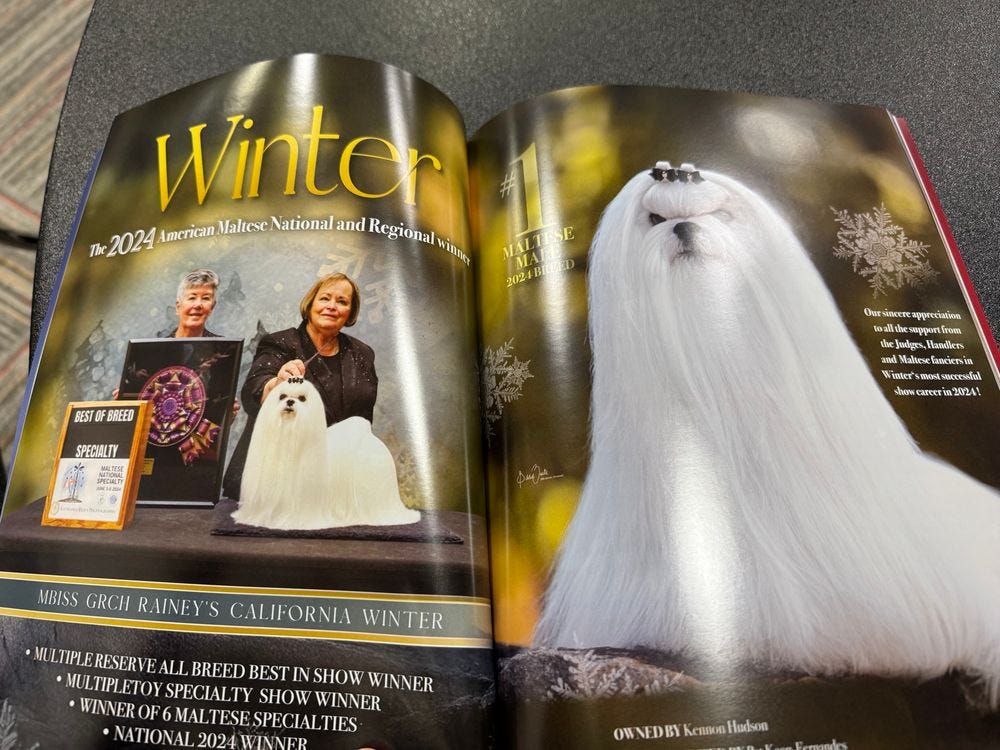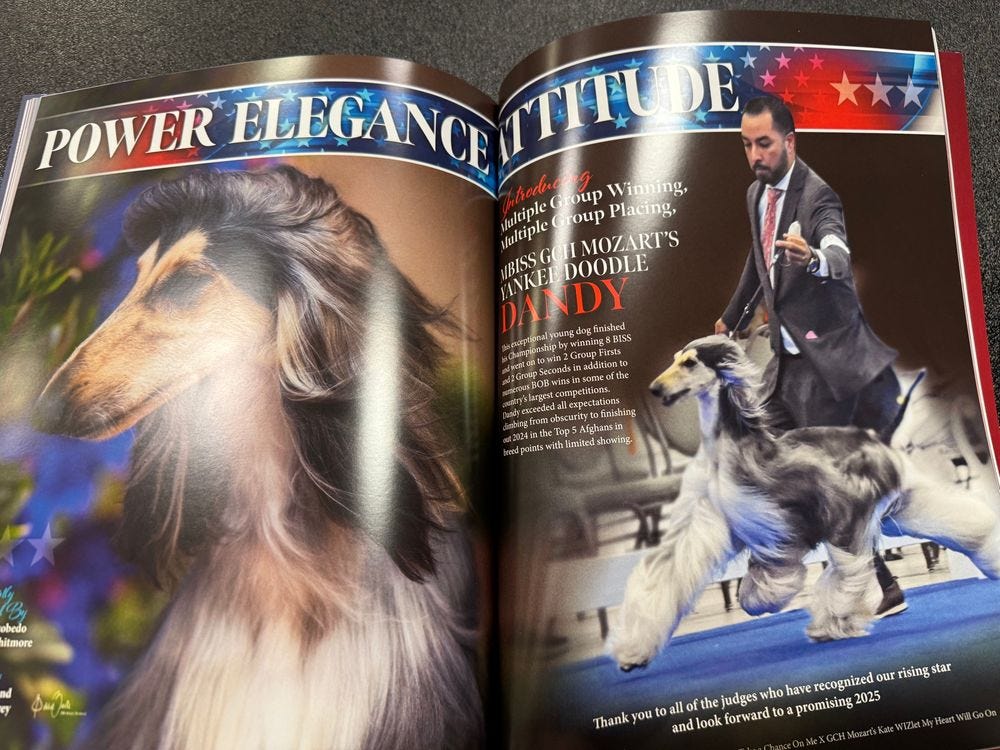3 things I learned covering the Westminster Dog Show
Or, I guess, two things I learned covering the dog show and one thing I understand way less than before.
I have covered so many of the biggest sporting events on earth: The Super Bowl. The Olympics. The NBA playoffs. College football’s national championship. But I have spent most of my career chasing one dream: Covering the Westminster Kennel Club Dog Show. I live in New York, where the dog show is held, but it’s typically the day after the Super Bowl, and when I was employed as a football writer, I would be too tired (or in transit) to cover the dogs.
But now that I run a newsletter where I cover whatever I want… DOG SHOW TIME.
I’m working on a video that I’m going to post on Youtube in a couple days, go ahead and subscribe here to get that when it drops. But I also wanted to write up some Dog Show Observations.
Seriously, they just let you pet the dogs
I can’t stress this enough. If you go to the Westminster Kennel Club Dog Show, you can just go pet the dogs.
(Clearly, I use the “right hand to the side of the neck scruff/ear region” dog-petting strategy. Effective and popular.)
I was able to pet well over 100 breeds of dog between two days at the Javits Center, potentially close to 150. (Still tallying the final total.) I think my numbers were boosted by the media pass hanging around my neck, which signaled to dog owners that I was there on official dog-petting business. I also think my numbers were boosted by the fact that dogs inherently understand that I am their friend, and that they yearn for my companionship and pets.
Not every dog is available for petting at all times. Many breeds require hours of meticulous grooming before going into the show ring, and those dogs’ owners aren’t going to let random people screw up two hours of blow-drying with a vigorous petting session. But there are two ways around this.
Firstly, Westminster is one of two annual “benched” dog shows in America, the other being the National Dog Show in Philadelphia on Thanksgiving. That means that when the dogs aren’t competing, they’re assigned to be present at a certain bench in the exhibition hall until the end of the competition. The idea, originally, was to create a peak pet store. If a certain dog catches your eye in the ring, you can go to the back, find the dog at its bench, connect with its owners and breeders, and arrange to purchase puppies. The first American dog show, all the way back in 1874, was a benched show for this reason.
That’s a lot of waiting. Some people show their dogs at 9 a.m. and have to sit around until 4 p.m. There are a lot of bored owners scrolling their phones, sitting around and waiting for people to ask them what makes their particular dog so special—and a lot of bored dogs looking at passersby, hoping for a sliver of attention. That’s petting time.
Secondly…. to be honest, the dogs with the meticulous grooming aren’t the ones that want to be pet anyway. You want to say hi to the dogs in the Big Doofus category, the ones which are massive and powerful enough to kill humans but, thankfully, have been bred over many generations to crave human friendship. These dogs are born with Bellyrub Addiction and they need a fix.
(Poor quality photo due to the speed of the pets.)
I felt like I was imposing when I pet the terriers. I felt like I was providing a great service to the St. Bernards and Newfoundlands. It’s worth the price of admission just to walk up and down Enormous Dog Avenue and lend a helping hand.
I cannot fathom how they pick the winners. But dog people know.
Before attending the dog show in person, the concept of dog judging broadly made sense to me. Each breed has an extremely standard—the breed standard for the Samoyed is 1,400 words long, outlining everything from the basics (recommended height, weight, and gait) to the highly specific (ear length, belly musculature, and paw-hair) to the completely intangible (“the dog… should present a picture of beauty, alertness and strength, with agility, dignity and grace.”)1 The judge searches for the dog in each breed which best fits those descriptors. It’s a closest to the pin contest, but for floofiness and floppiness. Got it.
But then I went to the dog show, and I cannot possibly imagine how they pick between the dogs. This is what the Samoyed group looked like:
THOSE ARE ALL THE SAME DOG! THEY’RE THE SAME SIZE AND SHAPE AND SMILE! THEY ALL “PRESENT A PICTURE OF BEAUTY, ALERTNESS, AND STRENGTH, WITH AGILITY, DIGNITY AND GRACE!”
I simply don’t know how the judges decide which of those Samoyeds is the best Samoyed. What’s more, I would rather die than imply that 12 of those 13 Samoyeds are, in any way, worse at being Samoyeds than the other Samoyeds.
But somehow, everybody seems to know which dogs are just there, and which dogs are there to win. The dog owners are able to handicap their breeds with remarkable accuracy, pointing at a line of identical dogs and saying “well that one typically wins,” and then sure enough, that one wins.
And the Best in Show winner, Monty the Giant Schnauzer, was the same dog that won best in show at the AKC National Championship in December2. This means that at two separate shows, Monty has been determined to a) conform to the Giant Schnauzer standard better than all the other Giant Schnauzers, all of whom look like Giant Schnauzers; b) conform more closely to the Giant Schnauzer standard than the Samoyed which most closely conforms to the Samoyed standard, even though all the Samoyeds look like Samoyeds; and c) conform more closely to the Giant Schnauzer standard than all the best dogs in the 198 other breeds conform to their breed standards.
To be clear, I am not criticizing Monty the Giant Schnauzer. I believe he does all the things Giant Schnauzers are supposed to do, like be 25.5 to 27.5 inches tall, and be “composed, watchful, courageous, easily trained, deeply loyal to family, playful, amiable in repose, and a commanding figure when aroused.” I just feel like all the other dogs also did great jobs of hitting their specified heights and adjectives and don’t know how it’s so clear that Monty won his second major competition in three months.
Is this what people who don’t understand the rules of sporting events feel like when they watch sports? This whole thing made more sense when I thought the judges just pointed to the dogs they liked the most.
There’s a business of beautiful dogs.
If you watch the dog show on TV, you’ll see ads for dog food. Makes sense, like ads for Nike and Jordan while you watch basketball. The ads say 96 of this year’s top 100 dogs use Purina Pro Plan. You probably have a dog if you’re watching the show—don’t you want your pup to be healthy and beautiful like the ones in the show?3
But actually at the show? The ads for dog food are still there, but you’ll also find… ads for the actual dogs. Like, ads for the dogs that are in the dog show.
Yesterday I was admiring a Komondor when I noticed that the Komondor’s owner had helpfully put out a magazine with pictures of Komondors in the front of their stall. That’s nice, I thought. A lot of people walking by might not know what Komondors are so I guess she put out a little magazine with fun facts and pictures.
But as I looked closer, I realized it wasn’t just an informative magazine about Komondors. It was a magazine with pictures of this Komondor, the one I was about to pet. It was like seeing the star of a movie walking in front of a billboard advertising that movie, except normally you do not get to passionately rub the side of the movie star’s face and tell them they are doing such a good job.
I was able to snag free copies of two dog trade magazines, Dog News and ShowSight. They are filled cover-to-cover with ads for the dogs in the show. I imagine the idea behind the ads is partly to catch the eyes of the judges, who surely read magazines like this. But also, the ads for the dogs are… ads for the dogs. Want a dog that looks exactly the one you saw at the dog show? Get in touch with the people in the ad!
There’s no monetary prize for winning the Westminster Dog Show4. In fact, it costs a lot of money. You’ve gotta take off work and travel to New York and get hotel rooms for multiple nights, plus lots of people hire pro handlers, and there’s a lot of grooming equipment, and you’ve gotta wear clothes with lots of sequins on them for some reason.
But if your dog wins? You’re gonna be able to charge a pretty puppy penny to people who want to say “… and her father won best-in-breed at Westminster.”
Plus, these ads are awesome.
I might take one out for my beagle, even though she’s spayed and has never won a damn thing. I just want a magazine to publish a full-page spread with pictures of her sleeping in dumb positions and “THE QUEEN IS HERE” in the live laugh love font.
The standard for the Newfoundland that I’m petting up at the top of the post: “Sweetness of temperament is the hallmark of the Newfoundland; this is the most important single characteristic of the breed.”
Of the seven best-in-group winners at Westminster, three (Monty, along with Mercedes the German Shepherd and Neal the Bichon Frise,) were also best in group at the AKC event.
And if you’d like your dogs to be more like my dogs, WHO ARE ALSO BEAUTIFUL, BY THE WAY, buy Kirkland Signature Adult Dog Formula kibble. Kirkland Signature: The official brand of Rodger.
Some shows do have prizes: The AKC National Championship gives a $50,000 grand prize, and the National Dog Show gives a $20,000 grand prize.









Great read, but how can you drop a teaser like that at the end and not include a picture of your puppy?
Kirkland Signature Kibble FTW!